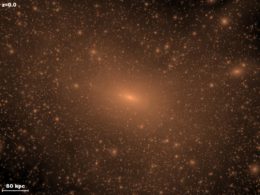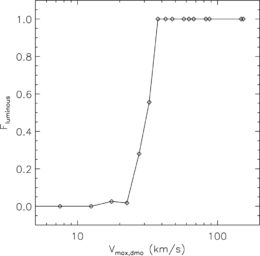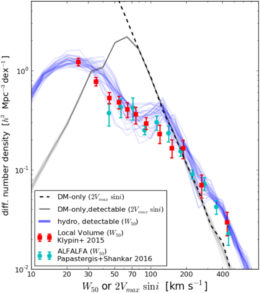One long-standing astrophysical puzzle is that of so-called “missing” dwarf galaxies: the number of small dwarf galaxies that we observe is far fewer than that predicted by theory. New simulations, however, suggest that perhaps there’s no mystery after all.
Missing Dwarfs

Dark-matter cosmological simulations predict many small galaxy halos for every large halo that forms. [The Via Lactea project]
Are these galaxies actually missing? Are our predictions wrong? Or are the galaxies there and we’re just not spotting them? A recent study led by Alyson Brooks (Rutgers University) uses new simulations to explore what’s causing the difference between theory and observation.

The fraction of detectable halos as a function of velocity, according to the authors’ simulations. Below ~35 km/s, the detectability of the galaxies drops precipitously. [Brooks et al. 2017]
Simulating Galactic Velocities
Because we can’t weigh a galaxy directly, one proxy used for galaxy mass is its circular velocity; the more massive a galaxy, the faster gas and stars rotate around its center. The discrepancy between models and observations lies in what’s known as the “galaxy velocity function”, which describes the number density of galaxies for a given circular velocity. While theory and observations agree for galaxies with circular velocities above ~100 km/s, theory predicts far more dwarfs below this velocity than we observe.
To investigate this problem, Brooks and collaborators ran a series of cosmological simulations based on our understanding of a ΛCDM universe. Instead of exploring the result using only dark matter, however, the team included baryons in their simulations. They then produced mock observations of the resulting galaxy velocities to see what an observed velocity function would look like for their simulated galaxies.
No Problem After All?

Comparison of theoretical velocity functions to observations. The black dashed line shows the original, dark-matter-only model predictions; the black solid line includes the effects of detectability. Blue lines show the authors’ new model, including the effects of detectability and inclusion of baryons. The red and teal data points from observations match this corrected model well. [Brooks et al. 2017]
- Galaxies with low velocities aren’t detectable by our current surveys.
The authors found that the detectable fraction of their simulated galaxies plunges as soon as galaxy velocity drops below ~35 km/s. They conclude that we’re probably unable to see a large fraction of the smallest galaxies. - We’re not correctly inferring the circular velocity of the galaxies.
Circular velocity is usually measured by looking at the line width of a gas tracer like HI. The authors find that this doesn’t trace the full potential wells of the dwarf galaxies, however, resulting in an incorrect interpretation of their velocities.
The authors show that the inclusion of these effects in the theoretical model significantly changes the predicted shape of the galaxy velocity function. This new function beautifully matches observations, neatly eliminating the missing dwarf problem. Perhaps this long-standing mystery has been a problem of interpretation all along!
Citation
Alyson M. Brooks et al 2017 ApJ 850 97. doi:10.3847/1538-4357/aa9576


4 Comments
Pingback: ¿Faltan realmente galaxias pequeñas? – Observatori Astronòmic
Pingback: Febrero 2018 – Observatori Astronòmic
Pingback: ¿Faltan realmente galaxias pequeñas? « SEDA / LIADA - RedLIADA - Cursos LIADA - Cielo del Mes - Fenómenos Astronómicos - RELEA
Pingback: Galaxias enanas perdidas « Sección de Astrofísica